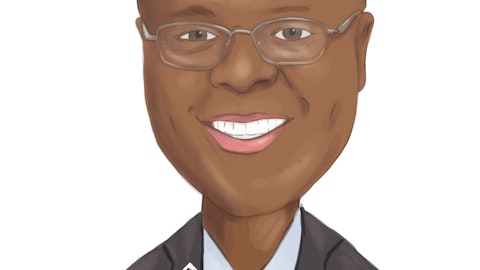Paul Perrault: I don’t think it’s because of funding or any other particular challenges, but it feels like the largest banks, which dominate our markets have really pulled back in a lot of areas and are not really participating as much as they had, which is one of the reasons why we’re seeing a fair amount of business. And the displacement, there were some of the failed banks were pretty active in all of our markets, and that created another level of opportunity. But I don’t know that there is a liquidity or capital problem that the people who are playing, the Boston market that you would have Eastern and you would have Rockland Trust people like that. Like us, some people in Rare Island, there’s a few banks there. But it’s our opportunity.
Nick Cucharale: And then lastly, can you just help us think about the effective tax rate for 2024?
Carl Carlson: Excellent. Tax rate is going to jump back up to about 24%. We had some tax-efficient investments that we had that phase out at the end of this year, so that for end of 2023. So it will jump back up to about 24%.
Nick Cucharale: Thank you for taking my questions.
Paul Perrault: Sure. Okay, Nick.
Carl Carlson: Thanks Nick.
Operator: The next question comes from Steve Moss with Raymond James. Steve, please go ahead.
Steve Moss: Good afternoon, guys.
Paul Perrault: Hey, Steve.
Carl Carlson: Hey, Steve.
Steve Moss: Maybe could you talk about a little bit on loan pricing here. Just on loan pricing, just curious where are new loans coming on and just color around that.
Carl Carlson: Sure. So I kind of told you in my notes, we hold $700 million of loans originated in the quarter, 727 basis points as the weighted average coupon on that. I’m not sure how much more detail you want. But it’s our equipment finance unit does particularly well, close to 10% for those loans.
Paul Perrault: Actually we drop that but it must be in spread right there.
Steve Moss: Okay. Appreciate that. And just given the end of period balance sheet, you look more liability sensitive given the borrowings here. Just kind of curious if we get some rate cuts, how you guys are thinking about the margin with rate cuts?
Carl Carlson: Everybody’s talking about rate cuts, so we’re — our book is fairly short, but not that short. So if they start cutting rates, we will have assets repricing a little faster than our liabilities. So it may take a little bit for us to catch up with that. But our borrowings, we have — that’s a benefit of borrowings and things of that nature, they do reprice fairly quickly and it depends on how fast we are able to adjust our market rates on our deposits. But I feel — we feel in pretty good shape there.
Steve Moss: Okay. I appreciate that. And then you guys are in a good capital position on — from a TC standpoint. Just kind of curious probably going to build a little bit this year. What are your thoughts around deploying the capital with an M&A transaction? And maybe how are M&A discussions these days.
Paul Perrault: M&A discussions these days. Its — right now, we have seen M&A pick up a little bit. There’s a few more deals being announced. I’d say the holes are still very big on many of these banks that are in the worst shape with very low NIMs and huge marks in their loan books and the security books. So I think that deploying capital to something like that is not something that we’re particularly anxious to do. I do think there is an opportunity, so there will be opportunities to do strategic deals that really makes sense. But more to come on that.
Carl Carlson: It’s a very difficult environment. Yes. That’s all
Steve Moss: Okay. Great. Well, thank you very much for all that
Carl Carlson: Okay Steve.
Paul Perrault: Thanks.
Operator: The next question comes from Laurie Hunsicker with Seaport Research. Laurie, please go ahead.
Q – Laurie Hunsicker: Yes. Hi. Thanks. Good afternoon.
Carl Carlson: Hi, Laurie.
Paul Perrault: Hi, Laurie.
Q – Laurie Hunsicker: Maybe your margin, just — spot margin for the month of December. Do you have that Carl.
Carl Carlson: I do. It was 310.
Q – Laurie Hunsicker: Okay. And then what was the accretion income number in net interest income this month.
Carl Carlson: For the month or for the quarter.
Q – Laurie Hunsicker: I’m sorry, this quarter.
Carl Carlson: Yes. So the quarter it was just under $2 million.
Q – Laurie Hunsicker: Okay. So less than last. Okay. And then noninterest income that the other category of $3.26 million, that looks outsized by a couple of million. What was that? And what’s nonrecurring in that number?
Carl Carlson: Yes, that’s the number that gets — has a lot of volatility in it because there’s a category in there is our mark-to-market on our risk participation agreements, which is really associated with swaps. So as rates change in the market, that gets marked every quarter. And so this quarter, it was roughly — it was just under $500,000 this quarter, and it was a loss of about $1.4 million in the prior quarter. So it was a big swing quarter-to-quarter in that number. And then we had some other noninterest income items that go through that as well.




